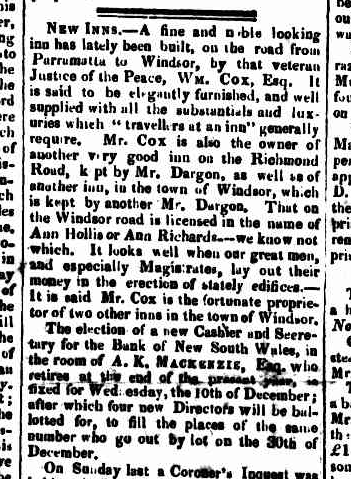
Establishment of the Inn
The White Hart was built on Windsor Road, between Paramatta and Windsor, on 110 acres of enclosed land in 1827 by James Gough, a pardoned convict, at the request of William Cox. Cox was the principal magistrate of the Hawkesbury region and throughout his career was heavily involved in the establishment and maintenance of travel routes across NSW. The White Hart Inn was officially opened in 1828, with Gough as the first publican. In the mid-1820s a regular coach service had been established between Paramatta and Windsor and the White Hart was one of many inns along the route which provided a rest-stop for travellers and their horses on the way. The White Hart is representative of typical inn-architecture in the 19th century and shares the uniform design of almost all inns in colonial NSW: a single storey, Georgian vernacular building with a verandah along the front, wing-rooms on either side and a second storey added later to provide additional accommodation.

Caption - Dixon's "Squatter's Map" 1837
Newspaper Article (1828)
This regional advertisement is dated to October 24, 1828, and is the first declaration of the White Hart Inn's establishment. The segment forms part of the third column in the ‘The Sydney Gazette and New South Wales Advertiser (NSW: 1803-1842)' which was produced for the people of New South Wales. Newspapers were made by a printing press which would have transferred the ink onto the paper (Musson 1958: 414).

Key (WHI0311)
Made from iron alloy, this completely intact key dates to the 19th century. The key was likely manufactured by a blacksmith or locksmith and was cast from melted iron. It was probably used by the publicans of the White Hart Inn.

Coach Travel Poster
Produced in 1870, this poster markets the operation of 'A Four Hose Drawn Carriage' from Sydney, to Parramatta and Windsor every Saturday. Coaches often provided passage for people across a large geographical expanse, and the presence of inns along their long passage would have offered a safe place for rest (Kottaras 2016: 32).
